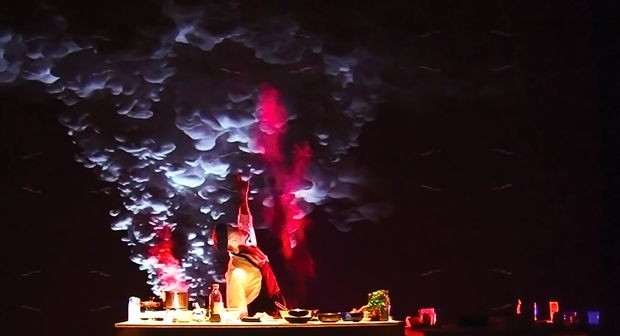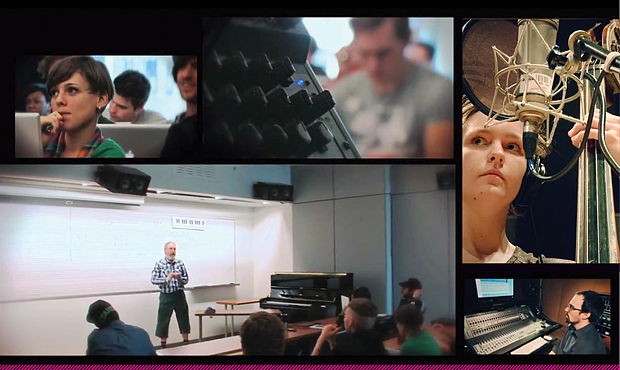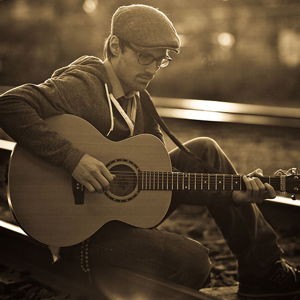In 1976, the membership transformed and the concerts started to incorporate “tape” (fixed media) compositions from musicians around the world. Over 35 years of these loudspeaker concerts, the Concordia Tape Archive expanded to approximately 3,500 pieces. In 1982 the group was renamed the Concordia Electroacoustic Composers Group/Groupe électroacoustique de Concordia. Its 400-plus concerts over the next 30 years included fixed media, multimedia, and live electroacoustics.
By the mid-1980s, Canada had 150 to 200 electroacoustic composers. Austin travelled across the country twice in 1985 to establish a Canadian organization that would have a better chance than individual composers of obtaining government funding. “The dean’s office and music department really supported these efforts,” Austin says. “And with 15 years of collecting electroacoustic musical compositions and presenting loudspeaker concerts, Concordia already had a solid reputation.” For the next 18 years, the university provided key logistical support to the Canadian Electroacoustic Community and still collaborates with the national organization.
Today, with more than 3,000 recorded compositions, Concordia has one of the world’s largest collections of electroacoustic music (and accompanying information), spanning 1972 through 1990. About one-third has been digitized for internet access so far and the Concordia Archival Project (CAP, cec.sonus.ca/education/archive). “Some considered it silly for us to store all those reels, but I knew it wouldn’t be long before people would want to know what this music sounded like a few decades back,” Austin says. “If you don’t have a culture’s artifacts, those cultural aspects remain only as mythology.”
In tune with technology, in 1984 the Department of Music became the first Concordia department to obtain a Macintosh computer. “It was clear that computers would open up a much bigger world in terms of manipulating sound. Professional recording studios had already been pushing for more soundtracks and by the mid-1980s were able to simultaneously record or mix 80 channels,” Austin says.
By 1990, computers and compact discs were in wide use for recording, manipulating and transmitting sound. “The need to reproduce music repeatedly from an original source basically vanished,” Austin notes. “Once we could send people an email with music in an attached file, or direct them to a website, the loudspeaker concerts weren’t as necessary anymore either.”
Austin decided to make 1990 the cut-off year for collecting new works for the archives. So much had already changed since the time he had envisioned one day dialing a telephone number to hear a composition. “My current students have never known a time when they couldn’t manipulate sound,” he points out. “They mix tracks on their smartphones.”
Impressive alumni
Graduates with an electroacoustic studies major or minor use their honed listening and sonic creativity skills to become sound designers, engineers, composers and producers, as well as well-known musicians such as Sarah Neufeld, BFA 03, and Richard Reed Parry, BFA 03, members of the Grammy Award-winning indie band Arcade Fire. “The program’s flexibility really encourages you to explore your own creative interests,” Neufeld says. (See the sidebar “Under the Dome: Arcade Fire’s Sara Neufeld” on page 45.)
Electroacoustic studies cover a gamut of electroacoustic, recording and sonic arts, including acousmatics (music integrated within a medium, such as a CD or computer file where it can be directly manipulated), spectromorphology (the study of the spectrum of sounds in a piece and their arrangement in time) and psychoacoustics (which delves into the physiological and psychological responses to sounds). “But the main focus has always been on training students’ outer, technical ear to recognize the quality in sound before they produce, manipulate or transform it,” Austin emphasizes. “The other key aspect is developing their imaginative, inner ear to use sounds in innovative ways.”


 Video still from Navid Navab’s “practices of everyday life — part I: cooking.”
Video still from Navid Navab’s “practices of everyday life — part I: cooking.”
 Concordia’s electroacoustic studies program provides students with a mix of compositional and theoretical courses in the eclectic musical field. Co-director Kevin Austin is pictured at bottom left in front of a classroom.
Concordia’s electroacoustic studies program provides students with a mix of compositional and theoretical courses in the eclectic musical field. Co-director Kevin Austin is pictured at bottom left in front of a classroom.
 Audio engineer, composer and music producer James Finnerty is one of many successful electroacoustic studies graduates.
Audio engineer, composer and music producer James Finnerty is one of many successful electroacoustic studies graduates.